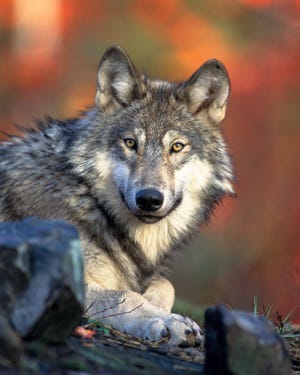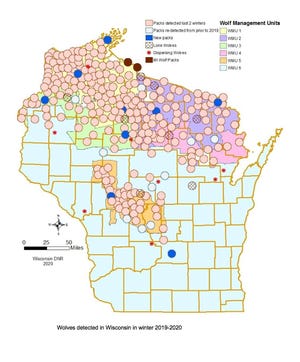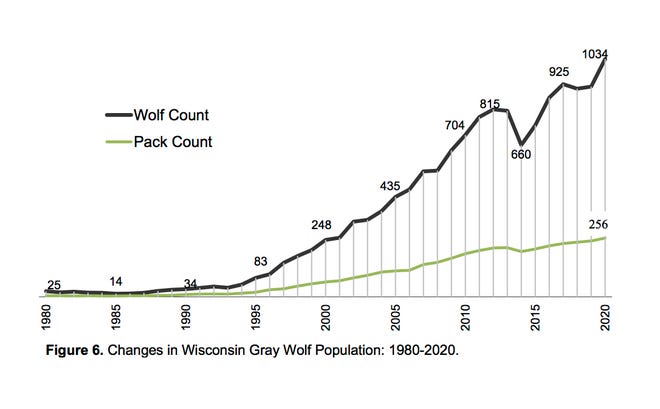 |
| Gray wolf |
In the U.S, wolves are now officially off the Endangered Species List. This means that states housing the animals now have the freedom to manage their respective populations. These methods include lethal measurements like retaliatory killing of wolves in response to livestock depredation, along with seasonal hunting and trapping. The decision was proclaimed by the U.S Fish and Wildlife Service in October 2020 and published in November of that year. It came into effect on January 4. One of the states holding high authority in wolf management is Wisconsin, where 528 wolves were killed through seasonal hunting and trapping from 2012 to 2014. The state's department of natural resources stated it intends to start its next wolf season on November 6 this year. The agency further added that it is working on a 10-year wolf management plan to help lead future management decisions in the state. Although wolves are delisted, shooting them is illegal unless there is a direct threat to human safety. Or, if on private land, a wolf can be killed if it is in the act of killing or maiming livestock or a pet. A report by the Wisconsin Department of Natural Resources indicated 90 confirmed or possible wolf depredations through the end of October, compared to full-year depredations of 82, 73 and 61 in 2019, 2018, and 2017, respectively. So far this year, there has been no depredation of a livestock or pet in Wisconsin. In addition, there has been no wolf attack on a human in the state's history.
 |
| A map showing Wisconsin's wolf packs recorded in a 2019-2020 winter tracking survey. |
It makes me uncertain what the future holds for wolves in the U.S following their delisting. I find that certain states managing their respective wolf populations is questionable. This is because when people resort to retaliatory killing of wolves, it would result in disarray of packs and bring more trouble to farmers and ranchers. That is, if some number of wolves are killed and one of them turns out to be an alpha leader, then the pack he was leading would become disorganized and its members recklessly would go killing livestock. This, in turn, would bring more trouble to farmers and ranchers who would further kill wolves in retaliation bringing their population numbers down. There could also be a possibility of some unexpected side effects stemming from wolf management. In Wisconsin, Minnesota, Idaho, and other wolf states, the threat of depredation is so explicit, that there is a possibility certain dog breeds resembling wolves could get shot and killed out of fear. One such case was reported in Canada in 2017. The breed was a Tamaskan dog named Kaoru, who worked as a therapy dog with children with autism and people with emotional problems. Other breeds susceptible to such accidental, yet heart-wrenching killings include huskies, malamutes, and German Shepherds.
 |
| Wisconsin wolf population from 1980-2020 |
I strongly urge various states housing wolves to consider using non-lethal methods to prevent depredation from the animals and other forms of human-wolf conflicts. One surefire way is to acquire livestock guardian dogs to protect the farm animals. Awareness programs should also be held to educate and enlighten farmers, ranchers, and other stakeholders who are uneasy living alongside wolves. These programs should highlight key points such as how wolves play a crucial role in sustaining the natural environment by keeping prey animal populations in check. This means that killing wolves would allow deer and other prey populations to increase and cause ecological imbalance to the ecosystems of such states. The threat of depredation by wolves is a direct result of people having converted their habitats into farmlands and wiped off their natural prey. It is because of this negative influence imposed by people that wolves have been preying on livestock.
No comments:
Post a Comment